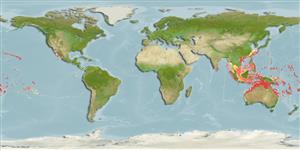Common names from other countries
Environment: milieu / climate zone / depth range / distribution range
Ecology
Marine; reef-associated; non-migratory; depth range 0 - 120 m (Ref. 1602). Tropical; 30°N - 33°S
Pacific Ocean: Ryukyu Islands to the Philippines and extending to Lord Howe, Rapa and Tuamoto islands. Replaced by Chaetodon madagascariensis in the Indian Ocean, Chaetodon xanthurus in southeast Asia, and Chaetodon paucifasciatus in the Red Sea (Ref. 37816).
Size / Weight / Age
Maturity: Lm ? range ? - ? cm
Max length : 12.5 cm TL male/unsexed; (Ref. 4859)
Dorsal spines (total): 12 - 14; Dorsal soft rays (total): 21 - 23; Anal spines: 3; Anal soft rays: 16 - 17. Body color is white with 4-5 chevron-shaped blackish bands on the sides. The posterior portion of the trunk, the adjacent dorsal and anal fins, and the posterior portion of the caudal fin are yellow. A vertical black bar runs (uninterrupted) across the eye (Ref. 4855). Snout length 2.3-3.0 in HL. Body depth 1.7-1.8 in SL (Ref. 90102).
Inhabit deep lagoons and seaward reefs. Occur singly or in pairs. Feed on algae and small benthic invertebrates (Ref. 1602). Oviparous (Ref. 205). Form pairs during breeding (Ref. 205). May hybridize with C. xanthurus. Minimum depth reported taken from Ref. 128797.
Life cycle and mating behavior
Maturities | Reproduction | Spawnings | Egg(s) | Fecundities | Larvae
Distinct pairing (Ref. 205).
Myers, R.F., 1991. Micronesian reef fishes. Second Ed. Coral Graphics, Barrigada, Guam. 298 p. (Ref. 1602)
IUCN Red List Status (Ref. 130435)
CITES (Ref. 128078)
Not Evaluated
Threat to humans
Harmless
Human uses
Fisheries: minor commercial; aquarium: commercial
Tools
Special reports
Download XML
Internet sources
Estimates based on models
Preferred temperature (Ref.
115969): 23.7 - 28.4, mean 26.8 (based on 202 cells).
Phylogenetic diversity index (Ref.
82804): PD
50 = 0.5000 [Uniqueness, from 0.5 = low to 2.0 = high].
Bayesian length-weight: a=0.02239 (0.01427 - 0.03512), b=3.24 (3.11 - 3.37), in cm Total Length, based on LWR estimates for this species & Genus-body shape (Ref.
93245).
Trophic level (Ref.
69278): 3.0 ±0.41 se; based on food items.
Resilience (Ref.
120179): High, minimum population doubling time less than 15 months (Preliminary K or Fecundity.).
Fishing Vulnerability (Ref.
59153): Low vulnerability (10 of 100).
